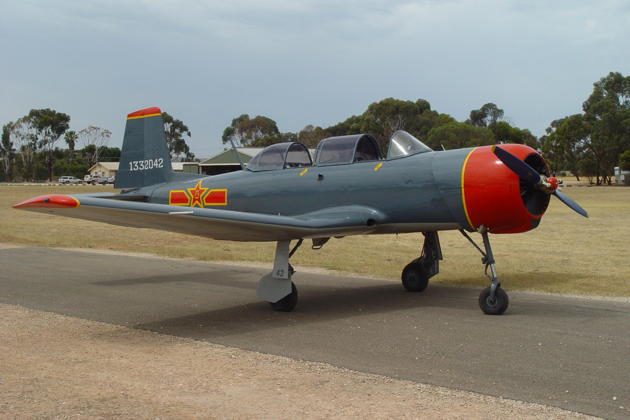FlightLog Archive
∟Aircraft Flown
Flying the Nanchang CJ-6 - Dec 2006
Australia had already given me an awesome day of powerful soaring conditions, and the chance to get acquainted with the members of the Adelaide Soaring Club in Gawler, South Australia.
After my enjoyable soaring flight, I was keeping as cool as possible in the 105 degree shade, and started talking with one of the club's towpilots, Kevin Lewis. Kevin mentioned that he was planning to bring his CJ-6 to Gawler the next day for some demonstration flights. I wasn't familiar with the CJ-6 nomenclature, until he mentioned the manufacturer - Nanchang. Kevin had obtained a Nanchang CJ-6 intermediate trainer, originally from the Chinese Air Force. Based on the Russian Yak-18, over 2,500 Nanchangs were built in China from 1950-1994 to be used as a military trainer. Kevin's CJ-6 was originally built in 1966. Powered by a 285hp radial engine, the CJ-6 is described as being very light on the controls and a pleasure to fly.
As they approach 4000 hours in service, the Chinese military tends to retire the aircraft, many in very good condition. In the late 1990's, entrepreneurs acquired the rights to a number of CJ-6s in the United States, Australia and New Zealand. Kevin obtained his CJ-6 in hundreds of crates, and he meticulously rebuilt it to the current outstanding condition. Kevin noted that the original overall paint scheme was an olive drab green, but he decided on a more striking gray with red accents, plus authentic insignia and lettering.
I arrived at Gawler airfield in mid-morning, and Kevin had just flown in from nearby Parafield airport, which is just north of Adelaide. After giving one demonstration flight, which included aerobatics overhead the field, Kevin taxied the CJ-6 back to the Gawler ramp area. We proceeded to do a full walk-around of the CJ-6, where I got to view the outstanding workmanship of the Nanchang design, including the smooth flush riveting and robust landing gear design.
Kevin's CJ-6 is in superb shape, including an immaculate cockpit. I got settled in the back seat, where Kevin walked through the controls and instrumentation, mostly in metric. Kevin cranked the radial engine, which settled into a beautiful rhythm as we taxied to runway 23 at Gawler. After a quick run-up, we accelerated quickly down the runway and were airborne, with a pretty strong landing gear shimmy right after takeoff. Kevin tapped the brakes, which quickly stopped the shimmy, retracted the gear, and handed over the CJ-6 to me!
Even on this 95 degree day, I climbed comfortably to altitude, and headed out over the Barossa Valley to check out the flight controls and the view. I was definitely enjoying the stick and throttle configuration, and was back in my element with the throttle on the left and no yoke! I cruised over the Barossa Reservoir Dam, enjoying the very light aileron forces and smooth controls.
Climbing above 3000' AGL, I headed back over the Gawler airfield to set up for some aerobatic work. I tried a number of barrel rolls, which were very enjoyable and easy to coordinate. I tried an aileron roll with nearly full stick deflection, and got close to the advertised 180 degree per second roll rate. I could definitely get used to have a bird like this in my hangar.
Too quickly after the sightseeing and aerobatics, it was time to descend for a pattern and landing. I guess I hadn't scared Kevin too much, since he called over the intercom to say that he would lower the gear and flaps, but it was my job to fly the pattern and landing from the backseat. Sweet!
Since the visibility is very good from the backseat, I had no problem aligning on downwind, and guessed at a throttle setting to keep our speed in a decent range. Although there was a sailplane aligned for takeoff on the left side of runway 23, there was enough room to set up for approach and landing on the right side. The forward visibility did get reduced in the flare, but with great peripheral views out the side, I was able to pull off a decent touchdown, and was happily surprised with Kevin's two thumbs up just after touchdown, especially since he trusted me enough not to scratch his baby!
Ground handling is aided by a brake handle on the left side of the stick, which I was searching for on the left console, so I gave the last part of the taxi over to Kevin to make sure the last few feet were his to get us stopped. We taxied in to the great radial engine sound, plus background hissing of the pneumatics as we shut down.
The CJ-6 is a fantastic warbird package, providing a great 'round engine sound', comfortable cockpit, and easy-to-fly system. Thanks, Kevin, for the great opportunity to fly your beautiful CJ-6!
 KASPRZYK
KASPRZYK







